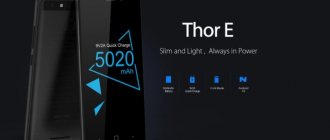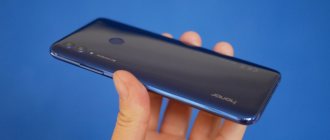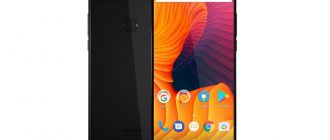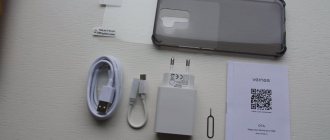HomePhone and Smartphone ReviewVernee Apollo – Review of a flagship smartphone with a 2K screen and an impressive set of…
Vernee Apollo is a flagship smartphone with a Helio X25 processor, a 2K display, 64 GB of internal memory, 4 GB of RAM and a 21-megapixel camera.
Smartphone Vernee Apollo – Reviews TehnObzor
Vernee is known for its high quality smartphones with an impressive range of features. In this review, we will find out whether customers' expectations were met this time.
Vernee Apollo design and build quality
Vernee Apollo is 152 mm long, 75.5 mm wide, and 9.7 mm thick. In the middle part, the smartphone is a little thicker, but still fits comfortably in the hand. At 185 grams, it's not the lightest 5.5-inch phone, but it's not too heavy either.
The frames are thin, only 3 mm. Can be operated with one hand. The body, with the exception of the front panel, is made almost entirely of aluminum; the antenna strips at the top and bottom are invisible. The power button and volume control are metal, located on the right, and have an ideal tactile response.
Instead of the typical Android touch keys, Vernee uses on-screen buttons. Because of this, part of the display area is occupied, but the keys can be customized. The indicator LED, which is located in the upper left corner above the display, flashes blue when notifications are received.
The main camera of the Vernee Apollo protrudes a millimeter from the rear panel. Next to it is a dual two-color flash and a fingerprint sensor. Apollo wakes up from sleep mode within one second of placing your finger on the sensor in 7 out of 10 attempts.
You can use one microSIM and one nanoSIM card at the same time, or insert a microSD memory card with a capacity of up to 128 GB instead of the latter.
The 3,180 mAh battery is not removable. The USB Type-C connector is located at the bottom. In general, the build quality and design are pleasing; Vernee can be a real competitor to Xiaomi or LeEco.
Smartphone screen
The Vernee Apollo IPS display with a resolution of 2560 x 1440 has a pixel density of an incredible 534 ppi. In fact, the use of a 2K display, a marketing ploy by large corporations like Samsung, may only be useful for those few who need an ultra-high definition screen for virtual reality technology.
Most users will not notice the difference between Full HD and 2K resolution displays. In addition, this negatively affects battery life and system performance.
Individual pixels are not visible, text on the screen remains readable even in bright sunlight, viewing angles are wide, and the contrast is sufficient. All image settings are made through the MiraVision application. Brightness is adjusted automatically.
The Apollo screen works quickly and accurately, accepting up to 5 clicks at a time. It is protected from scratches by Dragontrail tempered glass. The absence of 2.5D glass did not harm the tactile sensation; the transition from the plastic frame to the metal back panel was implemented perfectly.
Performance and OS
The Vernee Apollo smartphone runs on a virtually unchanged version of Android 6, which will please fans of this OS. The most popular Google applications are installed, including Gmail, YouTube and Google Play. I didn’t notice any errors or lags during testing; the system worked quickly. Updates are installed automatically.
The Helio X25 processor has 10 cores: 4 ARM A53 cores with a frequency of 1.4 GHz, 4 with a frequency of 2 GHz and 2 A72 cores with a maximum frequency of 2.5 GHz. Additionally, it is supported by Mali-T880 GPU and 4 GB of RAM. There is also 64 GB of internal memory - a standard amount for high-end smartphones.
RAM operates with a bandwidth of 6 GB/s, which is less than other flagships. Built-in memory read speed is 174 MB/s, write speed is 137 MB/s.
Apollo graphics will not be able to handle demanding 3D games on a 2K display. Asphalt 8, NOVA 3 and Modern Combat 5 cannot be played even at low settings. After 30 minutes of playing, the phone heats up to a maximum of 38 degrees - the heat is felt, but this is normal for such smartphones. For those looking for better performance at the same price, we can recommend the Xiaomi MI5 or LeEco Le Max 2 with Snapdragon 820 processor.
Camera Vernee Apollo
The main camera of Vernee Apollo is a 21-megapixel sensor with f/2.2 aperture. When there is enough light, you can get beautiful, detailed photos, but if the light gets weaker, the image quickly becomes blurry.
Photos come out of comparable quality to Le Max 2, but they are far from Xiaomi MI5. During video recording, the electronic stabilizer helps reduce image shake.
When shooting at 4K resolution, the maximum frequency is 27 fps. The image quality is generally good, but sometimes appears dull. Autofocus takes some time, but the shutter release mechanism is almost instantaneous.
The 8MP front camera with f/2.4 aperture takes blurry photos, even in good lighting.
Communication and Connection
All 2G, 3G and 4G (LTE) frequencies are supported:
- 2G: GSM B2/3/5/8
- 3G: WCDMA B1/8
- 4G: FDD-LTE B1/3/7/8/20
The connection quality is average. During calls, both parties can hear each other clearly, but there is a slight echo in the speaker, and background noise is not muffled at all.
Dual-band Wi-Fi module (2.4 + 5 GHz) provides fast wireless connection with a wide range. The old Bluetooth 4.0 protocol is disappointing. Vernee gadgets have to be connected manually each time.
The sound quality of the Vernee Apollo speaker drops even at medium volume. It's enough for ringtones and notifications, but not for listening to music, and the speaker itself is located so that the owner will constantly cover it with his hand while playing. When you connect headphones, the sound becomes much better.
In addition to the standard acceleration, brightness and proximity sensors, the Apollo smartphone also has a gyroscope and compass. The presence of a gyroscope allows you to use virtual reality glasses - a large 2K display also helps with this.
A compass is useful for navigation. By the way, GPS works quickly and is accurate to 4-5 meters. No errors were found during testing on a 150 km long track. For pedestrians, GPS will be just as useful.
Vernee Apollo battery
Vernee Apollo's 3,180 mAh battery, thanks to MediaTek Pump Express technology, charges from 20% to 80% in one hour - accordingly, a full charge takes 1.5 hours. While charging, the phone gets noticeably warm, but not too hot.
In an hour of playing FullHD video on YouTube over Wi-Fi, Apollo was discharged by 17%. From 100 to 50% it discharges slower than from 50 to 0%. In the PCMark test, the battery lasted 5.5 hours at medium brightness. For comparison, Xiaomi Mi5 lasted 12 hours in the same test.
When performing simple tasks, Vernee's charge will last you the whole day. Advanced users who are used to actively using their smartphone all day and are unable to recharge it should choose another option.
Bottom line
If you look at the new Vernee Apollo as an updated version of last year's Apollo Lite, only the camera and display are better. 64 GB of internal memory is also a good addition.
But the battery drains faster, and gaming performance remains the same low. The processor here is better, but due to the larger screen the load on it has become greater.
The phone is inferior to LeEco Le Max 2 and Xiaomi MI5 in almost everything. The only clear advantage of Vernee is that it can be used right away, without any software configuration.
Overall, Vernee Apollo is a good smartphone that, apart from a weak front camera and a mediocre battery, has no significant drawbacks.
Advantages
- Large display
- Excellent build quality
- Good main camera
- Stock Android with support for OTA updates
- Large memory capacity
Flaws
- Mediocre speaker
- Problems with 3D games
- Weak battery
Vernee Apollo smartphone – video review
- Price: $199.99
Vernee Apollo is a flagship smartphone from a young Chinese company that last year launched the Apollo smartphone with the Lite prefix. The younger version has a somewhat simplified, but almost identical external design, hardware platform and display. At the time of writing this article, both devices are on the market, and the difference in their cost is about $50. In this short article I will share my two-week experience using the older version of Vernee Apollo.
The text may and most likely does contain grammatical, spelling, punctuation and other types of errors, including semantic ones. I strongly encourage readers to point out these errors and correct me through private messages.
Design Vernee Apollo Lite
By tradition, we begin our review of the Vernee Apollo x 25 with its appearance. You can buy the device in one of two color options - white or black. The colors are classic, although the black has an inconspicuous purple tint.
The back and mechanical keys are made of metal, and to improve the quality of communication there are small plastic inserts at the ends. During testing there were a few small scratches on the back, so the case is highly recommended. It will also eliminate another problem - there are small joints between the plastic inserts and the metal into which dust gets clogged.
The main camera protrudes greatly beyond the body, and this despite the fact that it already has a considerable thickness of 9.2 mm. It would be fine if the glass was at least recessed relative to the protective rim, but no, it sticks out, which means that without a bumper it will be very easy to damage it.
The left side is occupied by a tray for micro + nanoSIM or microSIM + microSD. I would like to see a separate slot for a memory card, but this is not such a significant drawback, because 64 GB of internal memory will be enough for most users.
On the right side there is a power button and a volume rocker. They work well, but they have some slack.
The central space on the bottom edge is occupied by a USB-C port, on either side of which two slots are symmetrically located - for the main microphone and speaker.
The fingerprint scanner is located on the back; it only works well if you enter the same fingerprint into several slots in the database. There are 5 of them in total. On average, we have 8 successful operations out of 10 - a result typical of cheap devices.
Vernee Apollo helio x 25 review shows that the front panel is covered with Gorilla Glass 3 with a slight rounding at the edges. Over the course of several months of use, you should expect small scratches to appear on it, and this is subject to careful use. In this regard, for greater reliability, it is better to stick on protective glass from the first days. What is pleasantly surprising is the presence of an oleophobic coating, which is of quite high quality.
The speaker grille is slightly recessed relative to the glass, which is why it becomes clogged with dust as it is used and needs regular cleaning. To the left of it there is an LED event indicator, a front camera and the usual set of sensors.
The Vernee Apollo Lite smartphone was equipped with soft navigation keys, so the space under the display is simply empty.
The build quality can be given a four, deducting a point for the play of the mechanical keys and the poor design of the main camera.
Specifications
Screen:
5.5-inch IPS display with QHD (2560 x 1440) resolution;
protective glass Dragontrail Glass Case materials:
metal back with minimal plastic dividers near the ends
Colors:
dark gray and gold
Processor:
MediaTek MT6797T Helio X25 with 10 cores in three clusters: 2x Cortex-A72 (up to 2.5 GHz) and two clusters with 4 Cortex-A53 cores (up to 1.5 GHz)
Graphics:
Mali-T880
Operating system:
Android 6.0 Marshmallow (AOSP)
RAM:
4 GB (LPDDR3, 933 MHz)
User memory:
64 GB (eMMC 5.1) + the ability to install a memory card up to 128 GB instead of nanoSIM
Camera:
21 MP (f/2.2 aperture), Sony IMX230 sensor, LED flash;
front camera 8 MP (f/2.4 aperture), IMX219 sensor Network support:
GSM/EDGE (850/900/1800/1900MHz), WCDMA (900/2100MHz), FDD-LTE (Band 1/3/7/20/40 ), two slots for SIM cards (the first is nano, the second is micro and combined with microSD), one radio module
Wireless technologies:
Wi-Fi 802.11 a/b/g/n (dual-band: 2.4 and 5 GHz), Bluetooth 4.0, GPS / GLONASS, A-GPS support
Sensors:
fingerprint scanner, accelerometer, gyroscope, digital compass, distance and illumination
Additionally:
USB 2.0 Type-C port with USB-OTG support, fast charging using MediaTek PE technology, LED indicator
Battery:
3180 mA* h, non-removable
Supplied with:
power supply (5-12 Volt, 18 Watt), USB cable, paper clip for removing the tray, instructions and some kind of virtual reality helmet
Dimensions:
152 x 75.6 x 9.3 mm
Weight:
188 grams
Characteristics
The Apollo Lite smartphone has the following technical parameters:
| CPU | MediaTek Helio X20 (MT6797) |
| Number of Cores | 10 |
| Core clock speed | 4×1.4 GHz+4×2 GHz+2×2.3 GHz |
| GPU | Mali-T880 MP4 |
| Random access memory | 4 GB |
| Built-in memory | 32 GB |
| OS | Android 6.0 |
Display
Apollo has a display with QHD resolution, i.e. 2560 x 1440 pixels. The explanation for this move is the use of a smartphone as part of virtual reality glasses, which I already wrote about above. In everyday use, QHD resolution only gets in the way, because The performance and autonomy of the device decreases. The viewing angles of the display are maximum, the brightness adjustment range is excellent. In the sun, information from the screen can be read without problems. The fly in the ointment is a slow light sensor. When moving the smartphone from indoors to outdoors, it will take some time (~5 seconds) until the brightness reaches the appropriate value.
Hardware platform
The hardware platform used is MT6797T (Helio X25, 20nm) from MediaTek. The system-on-chip has 10 cores in three clusters (4+4+2): two high-performance Cortex-A72 cores (up to 2.5 GHz) and 8 Cortex-A53 cores, the frequency of which does not rise above 1.55 GHz for energy saving purposes. The indicated frequencies correspond to the chip installed in Vernee Apollo and may vary in other smartphones. Benchmarks
Despite all the theoretical power of this solution, in practice Helio X25, which is only a slightly overclocked version of Helio X20, still competes with the notorious “hot” SoC Spandragon 810, and in terms of graphics accelerator it hardly reaches the level of Snapdragon 801 (Adreno 330 ), released in 2014. And if when working with basic software there are no complaints about the chip, then in games the Mali-T880 MP4 can barely cope with average graphics settings. In the famous WoT: Blitz, it was never possible to get a full 60 frames, but you can still play on low graphics settings with drops of up to 30-40 FPS. In addition, there are still problems with the scheduler (operates with clusters and activates cores according to the load), which sends single-threaded workloads to slow Cortex-A53 cores, instead of using a high-performance cluster based on two Cortex-A72 cores. This flaw is especially evident in the Google Octane browser test. The drop in performance under prolonged load reaches 15-20%. Without a connected charger, the temperature of the back cover under load does not drop below 40 degrees Celsius. If you take the risk (and I took the risk) to play some resource-intensive game in a hot train compartment, when it’s +30 degrees outside, then nothing will work out. Apollo heated up to such a temperature that it was impossible to hold it in his hands. Here's what CPU-Z showed at that moment: Heating is typical for this smartphone for almost any reason, even when viewing photos in the gallery. In summer, this behavior causes noticeable discomfort. Work with RAM, like most other Chinese smartphones, leaves much to be desired. Despite as much as 4 GB of RAM, resource-intensive applications are unloaded from memory after minimizing. What’s more, even the tabs in the browser are reloaded. But I never managed to use more than 2.5 GB of RAM during the entire operation of the smartphone. Of the 64 GB of internal memory, about 53 are allocated for user needs, but by donating a nanoSIM it can be expanded using microSD cards up to 128 gigabytes.
Cameras
The rear camera in the Vernee Apollo Lite from Samsung, model S5K3P3, is 16 megapixels and has 6-lens optics, a pixel size of 1 micron, f/2.2. There is phase focus, a blue filter, and an ImagiQ image signal processor, which is more needed for a dual camera.
The image quality is good during the day in bright sunlight. It drops sharply at night or in poor lighting. Noise appears and detail decreases. The quality of the optics is low, as evidenced by blurring in the corners of the image. Focusing is slow, so many frames have to be deleted.
Communications and multimedia
Apollo is equipped with Bluetooth 4.0 modules, dual-band Wi-Fi a/b/g/n (2.4 and 5 GHz) and GPS/GLONNAS. With active A-GPS, satellites are detected quickly enough; there are no complaints about location accuracy and signal stability. To simplify orientation in space, there is a digital compass. The conversational speaker is clear and of high quality, I already wrote about the multimedia speaker above - there are few lows and “mess” at maximum volume. The quality of cellular network signal reception leaves much to be desired: where the Xiaomi Redmi 4A (the girl’s smartphone, it was possible to compare only with it) has 3G and half the bars on the reception indicator, the Apollo barely shows EDGE. Another complaint is the vibration signal. He may not be weak, but he is terribly nasty. This is typical for many budget smartphones, but after OnePlus 5 or iPhone I want to turn off vibration at the system level. The quality of music playback in the headphones is comparable to other smartphones - the volume is sufficient, there is no extraneous noise.
Vernee Apollo 2 and Apollo 2 Pro – release date, price
Vernee Apollo 2 is expected to be released in March 2020, and its improved version Vernee Apollo 2 Pro will be released in May.
Prices for the devices have not yet been announced, but we should expect some increase relative to the starting prices of devices this year.
- Vernee Apollo Lite went on sale in June 2020 for $230. By November 2020, its price dropped to $190 and this is a rather interesting offer for the Helio X20, capable of competing with analogues such as Xiaomi Redmi Note 4, Xiaomi Redmi Pro and LeEco Le 2
- Vernee Mars came out around the same time and at the same price: $230. By November, its price dropped to $200 and this is no longer the top offer on the Helio P10 processor: it is easily surpassed by the Meizu M3 Note and Meizu U20, the prices of which have already dropped below $130
- Vernee Thor is the most budget-friendly of the three and its price from the start of sales to this day was $120. However, solutions based on the low-performance MediaTek MT6753 chip are no longer relevant and the price of such smartphones is already below $100
The success of the new Apollo 2 will depend heavily on its price and speed to market. If the model becomes the first smartphone based on Helio X30, then it has every chance to conquer the user audience, no matter what price the vendor charges. If someone beats the Chinese manufacturer, then Apollo 2 may remain unknown...
Autonomy
The concepts of “5.5-inch QHD IPS display”, “3180 mAh battery” and “Helio X25 platform” are quite poorly compatible in terms of autonomy. In my usual mode of operation, the smartphone did not always last until the evening, which repeatedly forced me to resort to using an external battery. The average screen activity time was 3 hours. Autonomy tests
For fast charging, MediaTek PE+ technology is used, and the package includes a corresponding power supply capable of providing the device with a current of 2 Amps at 5/7/9 Volts and 1.5 A at 12 V. From 0 to 100 percent, the smartphone charges in 1 hour and 27 minutes.
Software
The Apollo software platform is built on Android OS version 6.0. We can see the so-called “pure” Android, for example, in Google’s Nexus line of smartphones, while in many Chinese devices we see the Android Open Source Project (AOSP). Interface
AOSP is a set of sources from which anyone with sufficient knowledge can assemble full-fledged firmware. The quality of the final software depends on the sufficiency of knowledge of this person (or team). It seems to me that this is one of the least expensive processes among Chinese smartphone makers. Today, the 6th version of Android is outdated, and many original Chinese brands (Bluboo, Elephone, etc.) are already selling devices with “seven” on board. The latter, by the way, has a very important (at least for me) feature that allows you to change the screen DPI without “dancing with a tambourine.” For some reason, many “Chinese basement” manufacturers set a very high DPI (around 600 units), which is why the interface becomes very large, and very little information fits on the screen. For comparison, a visual photo of Vernee Apollo Lite (the situation is similar in Apollo) and the iPhone 6S: I’m sure there are people who will like this solution, and for users like me there are instructions on how to change the DPI without root access. One of the shortcomings after the fix is a displaced row of navigation buttons. Of course, there were some minor bugs: on a locked screen, you can’t pull out the curtain to turn on the flashlight. Although if your battery charge is below 15%, then you will not be able to turn on the flashlight at all, because the system will not allow it due to the low battery charge. ¯_(ツ)_/¯
Equipment Vernee Apollo X
The smartphone comes in a black cardboard box, which also contains a USB-C cable, charger, paper clip and documentation. Recently, most manufacturers from the Middle Kingdom include a bumper in the package so that the phone is protected from the first days of use, but this was not the case here. But on each side the Vernee Apollo X 4gb 64gb is covered with a protective film.
Results
In Chinese online stores, the price of Vernee Apollo fluctuates around $200. Taking into account all the advantages and disadvantages, it’s hard to call such a price justified. If you have been looking closely at this smartphone and, quite obviously, are familiar with the specifics of shopping in Chinese online stores, then it would be much more advisable to spend these $200 on solutions from brands that have been tested by many users, be it Xiaomi, Meizu or Huawei.
What I liked:
- quality of materials and workmanship;
- display;
- fast charging;
- foldable VR glasses included in the package to get acquainted with virtual reality technology.
What I didn't like:
- performance in resource-intensive applications;
- problems with autonomy and software optimization;
- quality of pictures from both cameras;
- multimedia speaker;
- quality of cellular network signal reception;
- strong heating during charging and under high load;
- outdated version of Android;
- combined slot for memory card / SIM.
Thank you for your attention! The product was provided for writing a review by the store. The review was published in accordance with clause 18 of the Site Rules.
Manufacturer Vernee Model Apollo X Status Released Type Phablet Release Date February 2020 On Sale March 2020 Predecessor Vernee Apollo Lite Successor Vernee Apollo X
Main settings
IPS screen, 1080 x 1920 (FullHD), 5.5″, ~401 ppi Processor Mediatek Helio X20 (MT6797) Deca core Memory RAM: 4 Gb, Flash: 64 Gb, MicroSD: up to 128 Gb Battery 3500 mAh OS Android 6.0 Marshmallow Dimensions 151.8 x 75.6 x 9.5 mm
The Vernee Apollo X smartphone is based on the Mediatek Helio X20 (MT6797) chipset, has 4GB of RAM, a built-in storage capacity of 64GB and a screen with a resolution of 1080 x 1920.
Positive aspects of the subject:
- Memory expansion possible
- There is a 3.5 mm jack for headset and headphones
It’s strange, but we were able to find no downsides to the Vernee Apollo X. Other than that, there really are almost perfect gadgets!
Top The list may contain not only materials directly dedicated to Vernee Apollo X, but also those in which it is simply mentioned.
The physical dimensions of Vernee Apollo X are 151.8 x 75.6 x 9.5 mm with a screen diagonal of 5.5 inches. By modern standards, the device turned out to be quite thick (9.5 mm), especially considering that it is not a rugged smartphone. If the device's battery capacity were slightly larger than 3500 mAh, then this drawback could be forgiven. And so, alas, what we have is what we have.
Top
Unfortunately, at the moment we do not have data on the performance of this device in the AnTutu benchmark.
Top
- Smartphone: 1
- Charger: 1
- USB cable: 1
- User Manual (English): 1
- SIM card tray extractor: 1
Important note : equipment may vary depending on the device modification and country of delivery.
Top
Chipset Mediatek Helio X20 (MT6797) Deca core CPU 64-bit Yes GPU ARM Mali-T880 MP4 @ 780 MHz NPU No Process technology TSMC 20nm FinFET RAM 4 Gb - LPDDR3 @ 800 MHz (Single Channel) Built-in storage 64 Gb - eMMC 5.1 Expansion memory Yes Memory card types microSD, microSDHC, microSDXC Maximum capacity 128 Gb Dedicated slot No Resolution 1080 x 1920 (FullHD) Aspect ratio 9:16 Matrix type IPS Diagonal 5.5″ Area ~83.4 cm2 Fill percentage ~72.7% (of the total front surface area ) Pixel density ~401 ppi Protection Corning Gorilla Glass 3 Communication standards GSM, UMTS, LTE 2G GSM 850/900/1800/1900 MHz 3G UMTS 900/2100 MHz 4G LTE FDD-LTE 800/1800/2100/2600 MHz LTE support Yes LTE Categories Category-6 LTE Speed LTE device categories indicate the maximum speed at which it can send and receive data on 4G LTE networks through carrier aggregation. Number of SIM cards 2 Type of SIM cards Micro SIM, Nano SIM
Main camera
Type Single Resolution 13.0 MP (SONY IMX258) Autofocus Yes Aperture No data Flash LED
Front-camera
Resolution 5.0 MP (SAMSUNG S5K5E2) Aperture No data WiFi IEEE 802.11 a/b/g/n/ac, 2.4 GHz + 5 GHz, Wi-Fi Direct, DLNA, access point mode Wi-Fi is a technology for building wireless local area networks on based on the IEEE 802.11 family of standards.
Supported by all modern smartphones and many mobile phones. Bluetooth v4.0 Bluetooth is a universal wireless interface for exchanging data between various types of devices at close range. Can be used for file transfer, audio streaming, network connection, printing and other purposes. The newer the version, the greater the speed and number of supported profiles. GPS navigation For at least 10 years, smartphones have supported geolocation functions using data from satellite navigation systems. At the moment, these are the American-developed GPS, the Russian GLONASS, the Chinese BeiDou and the European GALILEO. As a rule, smartphones support the first two and optionally the rest. NFC No The built-in NFC module of a smartphone is mainly used for contactless payment in applications like Google Pay and Samsung Pay. Can also be used to read data from contactless cards, transfer files, etc. Read more here. Infrared port No Some smartphones have a built-in IR port. In the past, it was used to synchronize data both between two mobile phones and between a phone and a PC. However, now, due to its low speed, the infrared port is used mainly to control external devices in remote control mode. FM radio No Built-in radio receiver that allows you to listen to radio stations operating in the FM range. In most cases, it only works when headphones are connected, since the wire is used as a communication antenna. However, there are devices with a built-in antenna. 3.5 mm audio Yes Standard audio jack for connecting wired headsets and headphones. Starting in 2020, some smartphone manufacturers, following Apple, began to abandon it. In this case, to connect regular headphones, you need a special adapter for Lightning/USB Type-C. USB USB Type-C, On-The-Go The type of USB connector installed in the smartphone and the capabilities it supports. Sensors Light sensor, Electronic compass, Gravity sensor, Gyroscope, Hall sensor, Proximity sensor Fingerprint scanner Yes Scanner location On the back of the case Scanner reaction time 0.1 s Face scanner (Face ID) No Iris scanner (IRIS) No Battery capacity 3500 mA h Battery type Li-ion Removable battery No Fast charging Yes (18 W - 9 V x 2 A), MediaTek Pump Express 3.0 Wireless charging No Operating system Android 6.0 Marshmallow VOS shell Over-the-air (OTA) update Yes SMS messaging , MMS, Email, Push Email, IM Internet browser HTML5, CSS, JavaScript Audio formats AAC, FLAC, MP3, WAV Video formats 3GP, H.264, H.265, MPEG4 Graphic formats BMP, GIF, JPEG, PNG Voice assistant Google Assistant Dimensions 151.8 x 75.6 x 9.5 mm Weight 179 g Package dimensions 185.0 x 111.0 x 55.0 mm Package weight 433 g Protection level No Colors Black, Silver Geekbench 1601 / 3454 (Single core / Multi core) Vernee Apollo X performance rating according to popular data benchmark GeekBench. Average data are shown. AnTuTu No data PassMark No data Important note : unfortunately, we cannot guarantee 100% accuracy of all data presented on this page, but we are constantly working in this direction. If you notice an error in the device settings, we will be very grateful if you report it in the comments.
Top
Cameras Vernee Apollo Lite
Vernee Apollo review and camera specifications are not particularly impressive. The smartphone uses a module from Samsung - a 5 MP front camera and a 16 MP main camera with f/2.2 aperture. If during the day you can still get more or less tolerable pictures, then at night and in weak artificial lighting you can forget about the camera. All objects in the frame are hidden behind noise.
Focusing doesn't always work accurately—there's a lot of blur at the edges of most shots.
Example photo on Vernee Apollo Lite
The front panel is a little better than the main module, but you shouldn’t pin your hopes on it. A high-quality photo can only be taken in bright daylight.
Conclusion
Vernee Apollo Lite turned out to be a very controversial device, the advantages of which include the screen, performance when performing everyday tasks, the presence of a fingerprint scanner and fast charging. It has no less shortcomings - not the most successful design (in particular, the protruding front camera lens, which is very easy to damage), damp firmware, problems with autonomy and performance in games, disgusting cameras and a quiet main speaker. The Vernee Apollo Lite retails for around $200. For this money you can find a more suitable device with a Snapdragon 820 processor, which will be better in all respects.
Where can I buy?
Following the links you can buy a smartphone at the best prices:
Aliexpress GearBest
Comments for the
Cackl e
You might be interested in:











